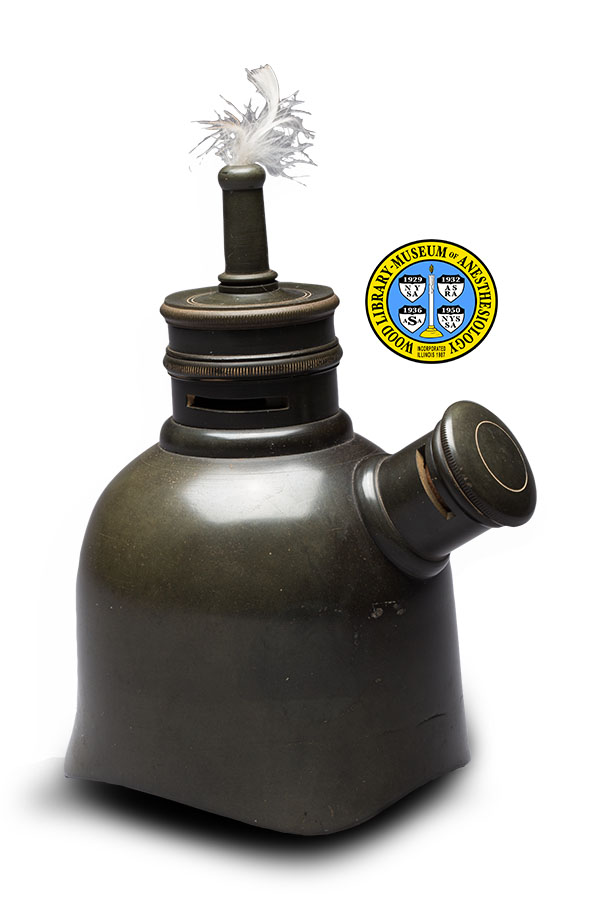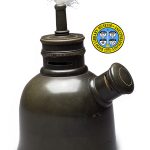Modified Junker Mask
Krohne & Sesemann Junker Mask
Dr. Ferdinand E. Junker (1828-1901) introduced the Junker Inhaler in 1867. He intended it to administer methylene bichloride (a mixture of chloroform and methyl alcohol), but it was soon being used to administer chloroform alone. Junker's design was sold by numerous equipment makers, and remained available for nearly eighty years. Throughout that time, at least fifteen named modifications were introduced, some by the leading anesthetists of the day.
The original manufacturer, Krohne and Sesemann, was a London surgical instrument maker founded in 1860. Krohne and Sesemann continued to make the Junker Inhaler, with modifications, for over forty years. By 1891, the company had introduced this modified mask. In Junker's original design, the top of the mask was connected to a hose. In this design, the connector holds a downy feather. The feather's sensitive response to air motion was a gauge of the patient's respiration. Krohne and Sesemann's modifications of the Junker Inhaler were available from several manufacturers through the 1930s. The example seen here was donated by the founder of the American Society of Anesthesiologists, Adolph Frederick Erdmann, M.D. (1867-1953.)
Catalog Record: Modified Junker Mask Junker Mask
Access Key: apos
Accession No.: 1937-08-29-1 Y
Title: [A modification of the Junker mask] / [designed by Ferdinand Ethelbert Junker] ; [modified by Krohne & Sesemann].
Corporate Author: Krohne & Sesemann.
Title variation: Alt Title
Title: Junker Inhaler Mask.
Publisher: [London?] : [Name of manufacturer not indicated], [between ca. 1890 and ca. 1940].
Physical Description: 1 anesthesia mask : vulcanite, metals, unidentified material ; 13.5 x 8 x 11 cm.
Subject: Anesthesia, Inhalation – instrumentation.
Subject: Chloroform – administration & dosage.
Subject: Masks, Anesthesia.
Subject: Junker von Langegg, Ferdinand Adalbert, 1828-1901.
Web Link: https://www.woodlibrarymuseum.org/museum/item/1055/modified-junker-mask
Note Type: General
Notes: The place of manufacture is likely to have been London, as all known manufacturers were based in that city. The first year in the date range is based on the earliest description of this design found by the cataloger (1891). The second year in the date range is based on the latest contemporary reference to Krohne and Sesemann Junker inhalers found by the cataloger (1935).
Note Type: General
Notes: On June 30, 1888, BMJ printed a letter to the editor in reply to a paper by Sir Spencer Wells. The signature appears as: “J. A. Junker, M.D., 30 Hyde Park Place W.” But the text leaves no doubt that the author was Dr. Ferdinand E. Junker. It states, in part: When I first devised, twenty years ago, my apparatus for the administration of bichloride of methylene….” It also states that Krohne & Sesemann were “the original makers.”
Note Type: General
Notes: The object is described from the patient’s point of view. The “nose” of the mask is considered the front.
Note Type: Citation
Notes: Bennion E. Antique Medical Instruments. London: Sotheby Parke Bernet, 1979.
Note Type: Citation
Notes: British Medical Journal. Reports and Analyses and Descriptions of New Inventions in Medicine, Surgery, Dietetics and the Allied Sciences. BMJ. June, 1891:1389.
Note Type: Citation
Notes: Buxton DW. Anaesthetics: Their Uses and Administration, 4th ed. Philadelphia: P. Blakiston’s Son & Co., 1907:219.
Note Type: Citation
Notes: Buxton DW. Anaesthetics: Their Uses and Administration, 6th ed. Philadelphia: P. Blakiston’s Son & Co., 1920:267-268.
Note Type: Citation
Notes: Hewitt FW. Anaesthetics and their Administration. A Manual for Medical Students and Dental Practitioners and Students. London: Charles Griffin and Company, 1893:194-200.
Note Type: Citation
Notes: Journal of the British Dental Association. Krohne and Sessemann’s improved chloroform inhaler. J Br Dental Assn. 1891;12:683.
Note Type: Citation
Notes: Junker FE. Description of a new apparatus for administering narcotic vapours. Medical Times and Gazette. November 30, 1867;2:590.
Note Type: Citation
Notes: Junker JA. On the administration of anaesthetics. BMJ. June 30, 1888;1(1435):1412.
Note Type: Citation
Notes: Krohne & Sesemann. Catalogue of Surgical & Orthopaedic Instruments Manufactured and Sold by Krohne & Sesemann. London: Printed by Samson & Co., 1878.
Note Type: Citation
Notes: Luke, Thomas D. Guide to Anaesthetics for the Student and General Practitioner, 2nd ed. Edinburgh: William Green and Sons, 1905:81-87.
Note Type: Citation
Notes: O’Neill, Charles. The safe administration of anaesthetics, with special reference to chloroform and methylene.” BMJ. June 12, 1897; 1(1902):1465-1466.
Note Type: Physical Description
Notes: One oro-nasal anesthesia mask, associated with the Junker inhaler; The mask is black, and might be made of vulcanite (as was usual), or possibly Bakelite; The body of the mask has a high dome, with an extension at the top of the dome and an expiratory valve on the back; Inside the mask, the apex of the dome has five openings, one round opening in the center surrounded by four oblong openings; Between the center opening and the oblong openings, four screws appear to hold the extension of the mask in place;
In front, the bottom edge of the mask has a smooth, arch-shaped notch that is designed to fit over the patient’s nose; This arch is less than 3 centimeters tall at its highest point, and approximately 3.5 centimeters wide at its widest point; On the back, and on the left and right sides, the bottom edge of the mask is scalloped; These scallops are less than .5 centimeter tall at the highest point and 4.5 centimeters wide at the widest point;
On the back, near the shoulder of the dome, the expiratory valve consists of a tube approximately 2 centimeters long and 2 centimeters in diameter; This tube has a cap that screws on and off; This cap is decorated with a single gold circle; Immediately below this cap there is a narrow, horizontal slot in the tube; Inside the tube, a circle of unidentified, pink material (possibly rubber) covers the point where the tube attaches to the body; This material is held in place by one screw which enters from the exterior; Inside the mask, this tube is attached by three, equidistant screws; Centered between these screws is a round opening, approximately .5 centimeter in diameter;
At the top of the mask there is a shoulder ring, approximately 4 centimeters in diameter, into which the extension is fitted; This extension consists of three parts; The lowest part, called for convenience the neck piece, is approximately 2.25 centimeters tall; There are two narrow, horizontal slots in this neck piece, each approximately 2.25 centimeters long; The neck piece can be turned 360 degrees in place, but does not appear to be removable; At its center (from top to bottom) this piece has a knurled ring that does not turn; This ring appears to be the point of attachment for the second part of the extension; This is a compartment that holds a small feather; This compartment has a round opening in the bottom; The compartment has a cap that screws on and off; This cap, the third part of the extension, is decorated with two, concentric, gold circles; The center of this cap is formed as a hollow post that is not removable; This post is approximately 2.5 centimeters tall, and ends in a nipple; When in use, the feather is inserted into this nipple.
Note Type: Reproduction
Notes: Photographed by Mr. Steve Donisch, November 14, 2016.
Note Type: Acquisition
Notes: Gift of Adolph Frederick Erdmann, M.D., (1867-1953). Born in the year that the Junker Inhaler was introduced, Dr. Erdmann later received the gift of a Junker Inhaler from the inventor, himself. In 1905, Dr. Erdmann founded the organization that was to become the American Society of Anesthesiologists (ASA). In 1937, he donated his collection of anesthesia equipment to the ASA’s fledgling museum, later named the Wood Library-Museum of Anesthesiology. Born in the year that the Junker Inhaler was introduced, Dr. Erdmann’s collection included several Junker inhalers.
Note Type: Historical
Notes: Dr. Ferdinand E. Junker (1828-1901) introduced the Junker Inhaler in 1867. He intended it to administer bichloride of methylene (a mixture of chloroform and methyl alcohol), but it was soon being used to administer chloroform alone. His design was sold by numerous equipment makers, and remained available for nearly 80 years. Throughout that time, at least 15 eponymous modifications were introduced, some by the leading anesthetists of the day. The first of these modifications was introduced just two years later, by Sir Frederic W. Hewitt (1857-1916).
Krohne and Sesemann, a London surgical instrument maker, was founded in 1860. The company remained in business until 1923, when it was acquired by Alfred Cox, Ltd. Junker stated in his first, 1867, description of his inhaler that it was made by Krohne and Sesemann; he noted that even at that date the company had introduced a modification, by adding a local anesthetic spray attachment. The company’s earliest known catalog, published in 1878, includes the Junker Inhaler. By 1891, the company had introduced the mask design represented in the cataloged object.
Junker’s original design features a dome-shaped mask made of vulcanite (a hard, moldable form of rubber.) On one side of the mask is an expiration valve. A short neck at the apex of the dome has at least one slot that admits air. The nipple in the top of the neck is a connecting port for a flexible hose, which led to a cylinder of liquid anesthetic. The Krohne & Sesemann mask shares most of these features, with an important exception. The neck is longer, with an extension that rises still higher. The nipple is at the top of the extension. Unlike Junker’s design, this nipple does not serve to connect the mask to the source of anesthetic. Instead, a downy feather is inserted there. The feather’s delicate response to air motion provides a gauge of the patient’s breathing.
Krohne & Sesemann introduced at least two other modifications of the Junker Inhaler. By 1897, it had changed the design of the mask once again. By 1905 the company had replaced the Inhaler’s double hand bulb with an arrangement of three bulbs. Krohne & Sesemann’s modifications of the Junker Inhaler continued in use through the 1930s.
Note Type: Exhibition
Notes: Selected for the WLM website


